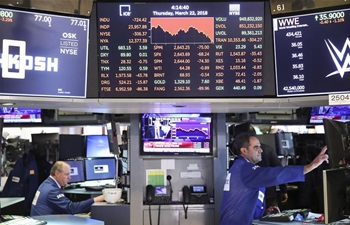WASHINGTON, March 26 (Xinhua) -- A report has shown that worsening land degradation caused by human activities, reaching "critical levels" in may parts of the world, is undermining the well-being of two fifths of humanity, driving species extinctions and intensifying climate change.
The land degradation might be a major contributor to mass human migration and increased conflict, according to the report released on Monday by the Intergovernmental Science-Policy Platform on Biodiversity and Ecosystem Services (IPBES).
The three-year report made by over 100 experts from 45 countries says the dangers of land degradation has costed the equivalent of about 10 percent of the world's annual gross product in 2010.
OVERCROPPING
Rapid expansion and unsustainable management of croplands and grazing lands is the most extensive global direct driver of land degradation, causing significant loss of biodiversity and ecosystem services including food security, water purification, the provision of energy and other contributions of nature essential to people.
"With negative impacts on the well-being of at least 3.2 billion people, the degradation of the Earth's land surface through human activities is pushing the planet towards a sixth mass species extinction," said Robert Scholes at University of the Witwatersrand in Johannesburg, a co-chair of the assessment.
"Wetlands have been particularly hard hit," said Luca Montanarella with European Soil Bureau, a co-author. "We have seen losses of 87 percent in wetland areas since the start of the modern era, with 54 percent lost since 1900."
According to the report, the world's first comprehensive evidence-based assessment of land degradation and restoration, land degradation has happened in many ways: land abandonment, declining populations of wild species, loss of soil and soil health, rangelands and fresh water, as well as deforestation.
Underlying drivers of land degradation, says the report, are the high-consumption lifestyles in the most developed economies, combined with rising consumption in developing and emerging economies.
By 2014, more than 1.5 billion hectares of natural ecosystems had been converted to croplands. Less than 25 percent of the Earth's land surface has escaped substantial impacts of human activity. The IPBES experts estimated this will have fallen to less than 10 percent by 2050.
The report says increasing demand for food and biofuels will likely lead to continued increase in nutrient and chemical inputs and a shift towards industrialized livestock production systems, with pesticide and fertilizer use expected to double by 2050.
WORSENING CLIMATE CHANGE
Also, the IPBES report finds that land degradation is a major contributor to climate change, with deforestation alone contributing about 10 percent of all human-induced greenhouse gas emissions.
Another major driver of the changing climate has been the release of carbon previously stored in the soil, with land degradation between 2000 and 2009 responsible for annual global emissions of up to 4.4 billion tons of carbon dioxide.
"In just over three decades from now, an estimated 4 billion people will live in drylands," said Scholes, "By then it is likely that land degradation, together with the closely related problems of climate change, will have forced 50 million to 700 million people to migrate," which will cause more social instability in dry areas.
"By 2050, the combination of land degradation and climate change is predicted to reduce global crop yields by an average of 10 percent, and by up to 50 percent in some regions," said Montanarella.
In the future, most degradation will occur in Central and South America, sub-Saharan Africa and Asia -- the areas with the most land still remaining that is suitable for agriculture, according to Montanarella.
"The assessment of land degradation and restoration by IPBES is a wake-up call for us all. It shows the alarming scale of transformation that humankind has imposed on the land and the changing nature of the forces driving land degradation," said Monique Barbut, executive secretary of the United Nations Convention to Combat Desertification.













